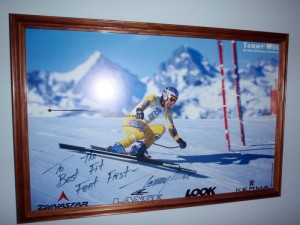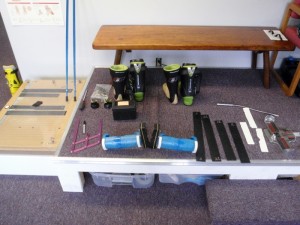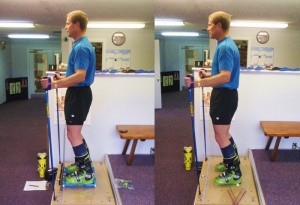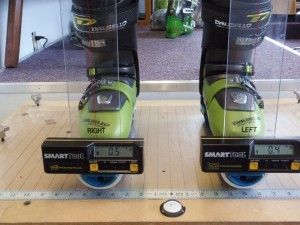Ski boots have come a long way in the past couple of decades, and with the improvements have come higher price tags. It’s not uncommon to spend $500, $600, $700 or more on high-end boots. But are you really getting your money’s worth?
First things first: If your boots are more than 3 or 4 years old, and you’re a “serious” skier (not just enjoying leisurely cruises down easier trails, but really wanting to feel your skis under you on a full range of terrain and snow conditions), you owe it to yourself to upgrade your boots. Boot development has lagged behind skis, and, until quite recently, most ski boots were still being made the way they were in the straight ski days: stiff fore-and-aft to pressure the tips and bend straight skis into a carving arc. But moderns “shape” skis don’t need to be pressured–just tip them on their sides and they turn for you. Boots can be relatively flexible fore-and-aft, but must be laterally stiff to easily and quickly lay the ski over on edge. The boot’s job is to let you get the ski on edge–the more you tip the ski, the sharper the turn.
Though most boot manufacturers are rethinking their designs and producing better boots for the modern skis, one of the best designs I’ve found (see Choosing Ski Boots: A Personal Journey), is Dalbello’s redesign of the old Raichle Flexon. The lateral stiffness of that 3-piece design made it beloved by racers who were laid way over on edge on straight skis, and it works for the new skis, as well. Add to the basic design some improved fit, and a heat-moldable liner inside, and you’ve got a recipe for some serious boots. Throw Glen Plake and his skill and experience into the redesign mix, and you’re pretty much guaranteed to have a boot that can perform at the highest levels.
But, notice the word “can.” Just because you’ve gotten a good boot does not mean it “will” perform the way you want it to. All high-end boots, but particularly the Dalbellos, are complex pieces of machinery with adjustments for cant, camber and, sometimes, fore and aft stiffness (“flex”). If they don’t all work together, the result could be worse than you’d expect. Wrong adjustments, in other words, could be worse than no adjustments.

This is where going to a professional makes a LOT of sense. You can buy some ski gear on eBay or Craigslist (poles, for instance) where you don’t need someone else’s expertise to make them work. But boots are different…no matter how technically savvy you are, you probably can’t set them up the way a professional can. Even if you ARE a professional, you can’t see yourself at the correct angles to know how your legs and knees are tracking, how you balance on the boots, whether the cant and camber are correct…you get the idea.
After I’d had my Dalbellos fitted by a qualified bootfitter, including heat molding the Intuition ID liners with my custom insoles in place, and had gotten some days on the slopes in them, it was clear that the boots were a great choice for me. I felt confident on them, easily controlled my skis, and was more comfortable than I’d been in years (heat-moldable liners are a wonderful thing, particularly if you have weird feet and bony ankles like mine!). Sounds like I’d gotten what I’d paid for, right? In some ways, yes. I’d bought new boots, and as hoped, could feel huge differences over my old ones. But…was I getting all that I’d paid for?
Getting The Ski Boot Performance You Paid For
Only one way to know…yes, go to the professionals. In my case, that’s Richelson’s Feet First in Plymouth, NH. Not only had they fitted my old boots and made my custom insoles a decade ago, they’re also one of the real cutting-edge facilities in the nation. A number of Olympic champions have trusted them to make sure they get the most from THEIR boots…who am I to argue with them? Plymouth’s a 2 hour, pain-in-the-neck drive from my house, but to get what they offer, it’s worth it. Paul Richelson has been fitting orthotics since the ’70s; “newbie” Brian McCall has been at it for a decade. In particular, Brian’s the specialist for fine-tuning ski boots…clearly the man to meet with!

Turns out I needed a “ski stance alignment”; making sure that the boot is set up so that my body’s natural position is ideal for skiing. Not many of us are perfectly aligned; we pronate, supinate, have bigger or smaller butts, have slight variations from one side of our body to the other. However, correctly set-up boots can help make up for that. I learned that lesson years ago, when a ski instructor watched me on the slope, then slipped a couple of shims under my boots to make up for deficiencies in my body alignment. It radically changed my skiing.
Now, the good news: a stance alignment costs $69.95. That’s 10 percent of the $700 price of the Kryptons, and a small price to pay if it makes a significant difference. The proof is in the pudding, as they say; time for me to turn myself over to the pros and see if the value is there!
Step one was to look at my old custom insoles; surprise, surprise, my body had changed in the past decade. Not a lot, but we’re talking about tiny increments to get the most out of ski boots, so everything counts. A few adjustments in key areas solved that problem.

With that done, Brian started to look at how the boots worked with my body. Good news: the basic setup was pretty close to correct. Between the shop bootfitter and my own tinkering, we’d done a good job. But, there were still a few things that could be improved. In particular, the boots had a tendency to force my hips forward; to maintain balance, I had to bring my shoulders back. NOT a great position to be in going down a mountain! Brian made a fore-aft adjustment that brought my hips to where they should be, and put me in a much more neutral position relative to the skis (see the before/after photo to the left).
Also, when I was standing evenly balanced, my right boot was 0.5 degrees on inside edge of the ski. But for straight tracking and faster edge engagement Brian recommended a full 1 degree.The left boot, however, had me at 0.4 degrees on the outside edge…that meant a significant shift before I would feel the inside edge engaging in a turn. In other words, my right turns would be slower to initiate than my left, my left leg would work harder, and tire out faster. Hmm. Brian worked his magic, made the changes, and sent me on my way.

So…what did the changes feel like, out on the slopes? In a word, revolutionary. First, having the edges set so that they’re ever so slightly engaged at all times made my skis feel more stable with less tip- wandering wiggle when just cruising along. Second, when I initiated a turn, it happened “NOW!”, not “now”. That alone was a huge help the day I ended up at Sunday River trying to keep up with two ex-racers in fast conditions. That feeling of the edge being RIGHT THERE for me at all times allowed me to go faster and feel safer.
Much bigger, though, was the change in fore-aft balance. Before, it felt like I had to be in the “back seat” to get the rear half of the ski fully engaged. Now, as soon as I tip the ski into a turn, I can feel the entire ski edge carving like a knife; it’s a beautiful feeling! And, with very minor weight shifts, I can easily dig hard into boilerplate, or ride up over a soft pile of crud. These are all things I could do before, but now it’s intuitive, almost part of my body, rather than something I force myself into. And, to not have that “back seat” feeling to get the rear half of the ski to work as one with the front is priceless; it’s not just a gain in confidence, it’s a totally different feeling of being safe at speed.
Ultimately, there’s no question but what it was worth the price, and more. When we test new skis I know that differences I feel are caused by the skis, not by my boots giving me an inaccurate picture of what the ski is doing; that’s incredibly important for evaluating skis. But, when I’m on my own skis, and I feel that instantaneous edge bite, with the whole ski working a perfect carve under me…isn’t that what skiing is all about? The joy of a bluebird day, fresh snow, and the skis singing under us is a big part of why we’re out there, and getting that last few percent out of my boots is giving me a whole lot more joy for not a lot of money.
What does this mean for you? Well, if you have old boots…don’t waste your time and money on a stance alignment. That’s simply throwing good money after bad. Get some new boots that are designed to work WITH your shape skis, not against them. But, if you’ve made the investment in the right pair of boots for you, and have had them properly fitted with custom insoles, take that final, extra step to make sure you are getting the ski boot performance you paid for. It will improve your skiing, you will have more fun from each and every day on the slopes, and you’ll get more out of your skiing dollar for years to come!


